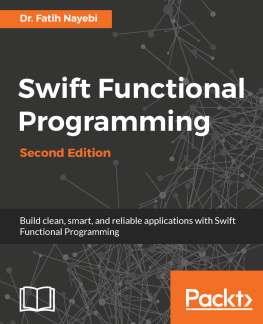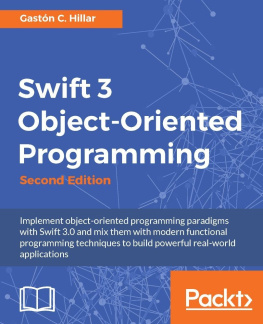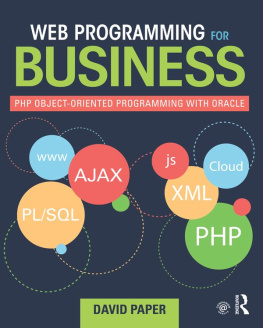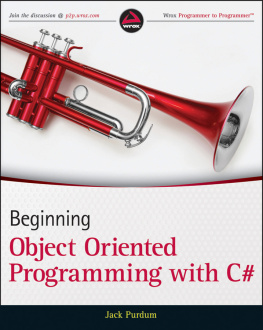Ashley Ehman - The Power of C++
Here you can read online Ashley Ehman - The Power of C++ full text of the book (entire story) in english for free. Download pdf and epub, get meaning, cover and reviews about this ebook. year: 2017, publisher: Cavendish Square Publishing, LLC, genre: Computer. Description of the work, (preface) as well as reviews are available. Best literature library LitArk.com created for fans of good reading and offers a wide selection of genres:
Romance novel
Science fiction
Adventure
Detective
Science
History
Home and family
Prose
Art
Politics
Computer
Non-fiction
Religion
Business
Children
Humor
Choose a favorite category and find really read worthwhile books. Enjoy immersion in the world of imagination, feel the emotions of the characters or learn something new for yourself, make an fascinating discovery.
- Book:The Power of C++
- Author:
- Publisher:Cavendish Square Publishing, LLC
- Genre:
- Year:2017
- Rating:4 / 5
- Favourites:Add to favourites
- Your mark:
- 80
- 1
- 2
- 3
- 4
- 5
The Power of C++: summary, description and annotation
We offer to read an annotation, description, summary or preface (depends on what the author of the book "The Power of C++" wrote himself). If you haven't found the necessary information about the book — write in the comments, we will try to find it.
Firefox, Chrome, and Internet Explorer are web browsers that are very different from one another, but they have one big similarity: large elements of each were written in C++. This volume introduces readers to important concepts like object-oriented programming while elaborating on the fascinating history of C++, providing examples of code, and exploring the relationship between C++, C, and C#.
The Power of C++ — read online for free the complete book (whole text) full work
Below is the text of the book, divided by pages. System saving the place of the last page read, allows you to conveniently read the book "The Power of C++" online for free, without having to search again every time where you left off. Put a bookmark, and you can go to the page where you finished reading at any time.
Font size:
Interval:
Bookmark:


Published in 2018 by Cavendish Square Publishing, LLC
243 5th Avenue, Suite 136, New York, NY 10016
Copyright 2018 by Cavendish Square Publishing, LLC
First Edition
No part of this publication may be reproduced, stored in a retrieval system, or transmitted in any form or by any meanselectronic, mechanical, photocopying, recording, or otherwisewithout the prior permission of the copyright owner. Request for permission should be addressed to Permissions, Cavendish Square Publishing, 243 5th Avenue, Suite 136, New York, NY 10016. Tel (877) 980-4450; fax (877) 980-4454.
Website: cavendishsq.com
This publication represents the opinions and views of the author based on his or her personal experience, knowledge, and research. The information in this book serves as a general guide only. The author and publisher have used their best efforts in preparing this book and disclaim liability rising directly or indirectly from the use and application of this book.
All websites were available and accurate when this book was sent to press.
Library of Congress Cataloging-in-Publication Data
Names: Ehman, Ashley.
Title: The power of C++ / Ashley Ehman.
Description: New York : Cavendish Square Publishing, 2018. | Series: The Power of coding | Includes bibliographical references and index.
Identifiers: LCCN ISBN 9781502634207 (pbk.) | ISBN 9781502629401 (library bound) | ISBN 9781502629418 (ebook)
Subjects: LCSH: C++ (Computer program language)--Juvenile literature. | Computer programming--Juvenile literature.
Classification: LCC QA76.73.C153 E46 2018 | DDC 794./1526--dc23
Editorial Director: David McNamara Editor: Caitlyn Miller
Copy Editor: Rebecca Rohan
Associate Art Director: Amy Greenan
Designer: Christina Shults
Production Assistant: Karol Szymczuk
The photographs in this book are used by permission and through the courtesy of: Photo credits: Cover Seyomedo/Shutterstock.com; p. 4 Michael Dwyer/Alamy Stock Photo; p. 7 The Hoberman Collection/Alamy Stock Photo; p. 9 Muratart/Shutterstock.com; p. 11 Bell Labs/Wikimedia Commons/File:Bell Labs Holmdel.jpg/CC BY SA 2.0; p. 13 Ksander/Shutterstock.com; p. 23 User:FA2010/Wikimedia Commons/File:IBM PC 1981 makffm.jpg/Public Domain; p. 28 Julia Kryuchkova/Wikimedia Commons/File:Bjarne-stroustrup.jpg/CC BY SA 2.5; p. 30 Gbuglok/ Shutterstock.com; p. 37 Markus Mainka/Shutterstock.com; p. 41 Oleg Doroshin/Shutterstock. com; p. 43 RedPixel.pl/Shutterstock.com; p. 50 David J. Green Lifestyle/Alamy Stock Photo; p. 54 DC Studio/Shutterstock.com; p. 57 Evan-Amos/Wikimedia Commons/File:Wii-gamecube-compatibility.jpg/Public Domain; p. 62 Maksim Kabakou/Shutterstock.com; p. 68 Sopotnick/ Shutterstock.com; p. 70 Twin Design/Shutterstock.com; p. 72 Indypendenz/Shutterstock. com; p. 74 Africa Studio/Shutterstock.com; p. 79 360b/Shutterstock.com; p. 83 Alice Photo/ Shutterstock.com; p. 85 Dragon Images/Shutterstock.com; p. 88 Rob Monk/Edge Magazine/ Getty Images; p. 90 Ditty About Summer/Shutterstock.com; p. 94 Venimo/Shutterstock.com; p. 95 The Ball - by Teotl Studios - http://www.theballthegame.com/Wikimedia Commons/ File:The Ball - Screenshot 06.jpg/CC BY SA 3.0; p. 97 George W. Bailey/Shutterstock.com.
Printed in the United States of America


Opposite : The way that students learn in the classroom has been greatly influenced by modern technologies, such as laptop computers .

T ake a look around you. Perhaps you are at home, reading this book in your room, or even at school, skimming these pages during your study period. You might see someone clicking away at a laptop, or a friend texting on their smartphone. Not so long ago, this would have been a much different picture. Instead of these modern conveniences, you would have seen people communicating on a large, bulky, desktop computer complete with clunky keyboard or a landline telephone. Yet, technology has a way of evolvingand expanding.
Aside from their physical appearances, the devices that you use are only as advanced as they are because of the computer programmers who gear them toward everyday people. A big part of emphasizing usability is creating effective coding languages that can adapt as technology does. One such adaptable language is C++.
Like the technology it drives, C++ had a somewhat complicated history before finally becoming the language we know it as today. As it stands, C++ is used in a variety of platforms and serves as the inspiration for many of the languages that were developed after it. Its status as a general-purpose programming language makes it useful in nearly every application that implements C++. This is because it can be adapted to fit the needs of the program. Where other languages specialize in particular programming tactics, C++ serves as a catchall in the programming community. While it was influenced by a lot of other programming languages, Simula 67 was the one that influenced C++ the most. Simula 67, or Simula for short, was a programming language created in the 1960s to run computer simulations. It is from this language that a programmer named Bjarne Stroustrup first began forming his main ideas of what C++ should be. During his time as a student at the Computing Laboratory of Cambridge University in London, Stroustrup became more and more familiar with Simula. One of the main things that stood out to him was the languages ability to map out his ideas into actual constructed code known as classes . Because of its use of classes, Simula was incredibly readable to the programmer. Classes also made Simula much easier to understand for those who were not familiar with a chunk of codes purpose.

Bjarne Stroustrup studied at Cambridge University in London, where he learned a great deal about what he would eventually turn into C++.
Along with its easily understood syntax (the grammar of the code itself), the language also allowed for fewer errors to occur when the program began running, thanks to its ability to recognize type errors. A type error is when a program acts in an undesirable way. Type errors are due to an irresolvable difference between the kind of data being placed into the program and what the program is supposed to do with this data. Think of it this way: a raw egg and a hard-boiled egg are both eggs, but only one can make a cake. In this example, the egg is the variable (think of a variable as a container for storing data). The hard-boiled versus raw characteristic is its data type. Finally, the cake at the end of the process is the program. While Simula had strengths in its zero-level abstraction and ability to pick out type errors, Stroustrup saw that it also had its downfalls.
As he worked more and more with Simula, he noted a few things that were undesirable about the language. As his projects grew in size and scope, Stroustrup became increasingly more aware of Simulas inability to grow with his programs. When he asked his programs to communicate with separate classes, he ran into time issues. The time it took to run the programs was not as quick as it had been when his programs were smaller. In addition, he found that what is known as runtime performance was also poor. This meant that it was unrealistic to continue running simulations, as the data retrieved would be essentially useless. As a last-ditch effort to save his project, Stroustrup rewrote the entire thing using a more machine-oriented language called BCPL. The problems hed encountered with Simula were so severe that if he had not rewritten his project, he would not have earned his PhD. His final project ran at speeds that were desirable. However, BCPL lacked the simplistic implementation that Simula had offered.
Font size:
Interval:
Bookmark:
Similar books «The Power of C++»
Look at similar books to The Power of C++. We have selected literature similar in name and meaning in the hope of providing readers with more options to find new, interesting, not yet read works.
Discussion, reviews of the book The Power of C++ and just readers' own opinions. Leave your comments, write what you think about the work, its meaning or the main characters. Specify what exactly you liked and what you didn't like, and why you think so.

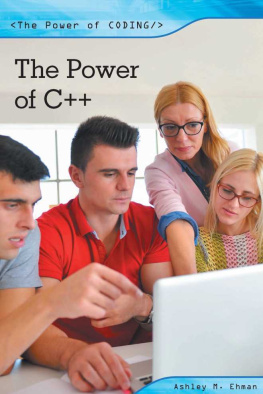
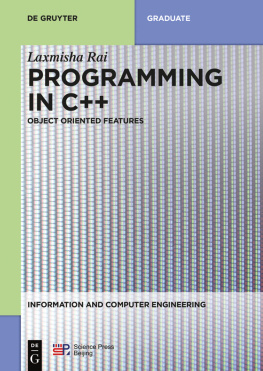

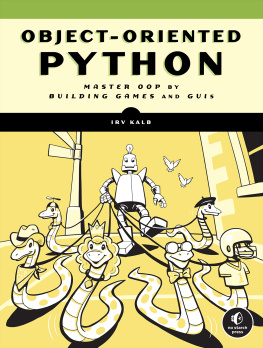
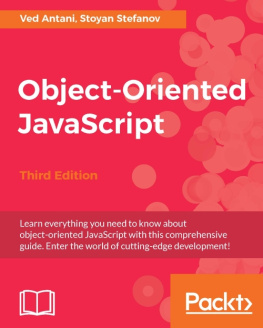
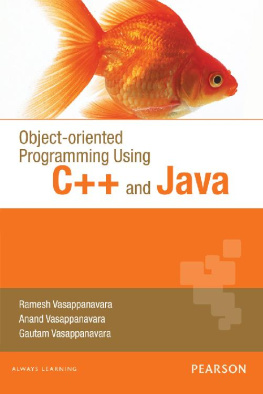
![Gastón C. Hillar [Gastón C. Hillar] - Object–Oriented Programming with Swift 2](/uploads/posts/book/119341/thumbs/gastg-n-c-hillar-gastg-n-c-hillar.jpg)
